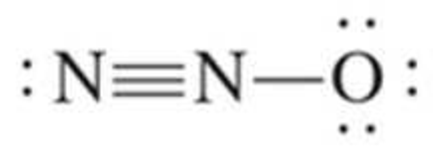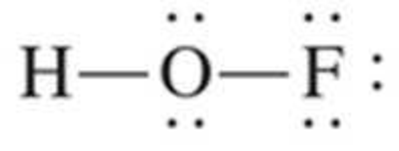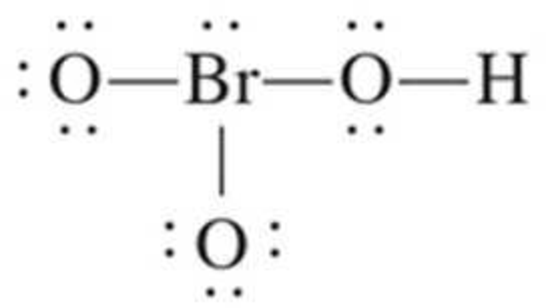
Study Guide with Selected Solutions for Stoker's General, Organic, and Biological Chemistry, 7th
7th Edition
ISBN: 9781305081086
Author: STOKER, H. Stephen
Publisher: Brooks Cole
expand_more
expand_more
format_list_bulleted
Concept explainers
Textbook Question
Chapter 5, Problem 5.25EP
Identify the coordinate covalent bond(s) present, if any in each of the following molecules by listing the two atoms involved in the bond. Name the atom on the left or the bottom in the bond first.




Expert Solution & Answer
Trending nowThis is a popular solution!

Students have asked these similar questions
Which of the following dienophiles is most reactive in a Diels-Alder reaction:
Please explain why the correct answer to this question is option 5. Please provide a detailed explanation.
Which of the following would you expect to be aromatic? Please provide a detailed explanation.
Draw the enantiomer and diastereomers of the following molecule. Label each type of
stereoisomers. Label each chiral center as R or S.
HO
Chapter 5 Solutions
Study Guide with Selected Solutions for Stoker's General, Organic, and Biological Chemistry, 7th
Ch. 5.1 - Covalent bond formation most often involves...Ch. 5.1 - Which of the following concepts is closely...Ch. 5.1 - Prob. 3QQCh. 5.1 - Prob. 4QQCh. 5.2 - Prob. 1QQCh. 5.2 - Prob. 2QQCh. 5.2 - Prob. 3QQCh. 5.2 - Prob. 4QQCh. 5.2 - Prob. 5QQCh. 5.2 - Prob. 6QQ
Ch. 5.3 - Prob. 1QQCh. 5.3 - Prob. 2QQCh. 5.3 - Prob. 3QQCh. 5.3 - Prob. 4QQCh. 5.3 - Prob. 5QQCh. 5.4 - Prob. 1QQCh. 5.4 - Prob. 2QQCh. 5.4 - Prob. 3QQCh. 5.5 - Which of the following is an incorrect statement...Ch. 5.5 - Prob. 2QQCh. 5.5 - Prob. 3QQCh. 5.6 - Prob. 1QQCh. 5.6 - Prob. 2QQCh. 5.6 - Prob. 3QQCh. 5.6 - Prob. 4QQCh. 5.6 - Prob. 5QQCh. 5.7 - Prob. 1QQCh. 5.7 - Prob. 2QQCh. 5.7 - Prob. 3QQCh. 5.8 - Prob. 1QQCh. 5.8 - In VSEPR theory, an angular molecular geometry is...Ch. 5.8 - Prob. 3QQCh. 5.8 - Prob. 4QQCh. 5.8 - Prob. 5QQCh. 5.9 - Prob. 1QQCh. 5.9 - Prob. 2QQCh. 5.9 - Prob. 3QQCh. 5.9 - Prob. 4QQCh. 5.10 - Prob. 1QQCh. 5.10 - Prob. 2QQCh. 5.10 - Prob. 3QQCh. 5.10 - As the difference in electronegativity between two...Ch. 5.10 - Prob. 5QQCh. 5.10 - Prob. 6QQCh. 5.11 - Prob. 1QQCh. 5.11 - Prob. 2QQCh. 5.11 - Prob. 3QQCh. 5.11 - Prob. 4QQCh. 5.11 - Prob. 5QQCh. 5.12 - Prob. 1QQCh. 5.12 - Prob. 2QQCh. 5.12 - Prob. 3QQCh. 5.12 - Prob. 4QQCh. 5.12 - Prob. 5QQCh. 5.12 - Prob. 6QQCh. 5 - Contrast the types of elements involved in ionic...Ch. 5 - Contrast the mechanisms by which ionic and...Ch. 5 - Prob. 5.3EPCh. 5 - Prob. 5.4EPCh. 5 - Indicate whether or not covalent bond formation is...Ch. 5 - Indicate whether or not covalent bond formation is...Ch. 5 - Draw Lewis structures to illustrate the covalent...Ch. 5 - Draw Lewis structures to illustrate the covalent...Ch. 5 - How many nonbonding electron pairs are present in...Ch. 5 - How many nonbonding electron pairs are present in...Ch. 5 - The component elements for four binary molecular...Ch. 5 - The component elements for four binary molecular...Ch. 5 - Specify the number of single, double, and triple...Ch. 5 - Specify the number of single, double, and triple...Ch. 5 - Convert each of the Lewis structures in Problem...Ch. 5 - Convert each of the Lewis structures in Problem...Ch. 5 - Prob. 5.17EPCh. 5 - Prob. 5.18EPCh. 5 - Prob. 5.19EPCh. 5 - Identify the Period 3 nonmetal that would normally...Ch. 5 - How many valence electrons do atoms possess that...Ch. 5 - Prob. 5.22EPCh. 5 - What aspect of the following Lewis structure...Ch. 5 - What aspect of the following Lewis structure...Ch. 5 - Identify the coordinate covalent bond(s) present,...Ch. 5 - Identify the coordinate covalent bond(s) present,...Ch. 5 - Without actually drawing the Lewis structure,...Ch. 5 - Without actually drawing the Lewis structure,...Ch. 5 - Prob. 5.29EPCh. 5 - Prob. 5.30EPCh. 5 - Draw the Lewis structure for each of the molecules...Ch. 5 - Draw the Lewis structure for each of the molecules...Ch. 5 - Draw Lewis structures to illustrate the bonding in...Ch. 5 - Draw Lewis structures to illustrate the bonding in...Ch. 5 - How many electron dots should appear in the Lewis...Ch. 5 - Prob. 5.36EPCh. 5 - Draw Lewis structures for the following polyatomic...Ch. 5 - Draw Lewis structures for the following polyatomic...Ch. 5 - Draw Lewis structures for the following compounds...Ch. 5 - Draw Lewis structures for the following compounds...Ch. 5 - Draw Lewis structures for the following molecules...Ch. 5 - Draw Lewis structures for the following molecules...Ch. 5 - In which of the following pairs of diatomic...Ch. 5 - In which of the following pairs of diatomic...Ch. 5 - Prob. 5.45EPCh. 5 - What is the molecular geometry associated with...Ch. 5 - Specify the molecular geometry of each of the...Ch. 5 - Specify the molecular geometry of each of the...Ch. 5 - Prob. 5.49EPCh. 5 - Prob. 5.50EPCh. 5 - Prob. 5.51EPCh. 5 - Prob. 5.52EPCh. 5 - Prob. 5.53EPCh. 5 - Prob. 5.54EPCh. 5 - Using VSEPR theory, predict the molecular geometry...Ch. 5 - Using VSEPR theory, predict the molecular geometry...Ch. 5 - Prob. 5.57EPCh. 5 - Specify both the VSEPR electron group geometry...Ch. 5 - Prob. 5.59EPCh. 5 - Prob. 5.60EPCh. 5 - Using a periodic table, but not a table of...Ch. 5 - Using a periodic table, but not a table of...Ch. 5 - Prob. 5.63EPCh. 5 - Prob. 5.64EPCh. 5 - Place + above the atom that is relatively positive...Ch. 5 - Place + above the atom that is relatively positive...Ch. 5 - Rank the following bonds in order of increasing...Ch. 5 - Rank the following bonds in order of increasing...Ch. 5 - Classify each of the following bonds as nonpolar...Ch. 5 - Classify each of the following bonds as nonpolar...Ch. 5 - Prob. 5.71EPCh. 5 - Prob. 5.72EPCh. 5 - Fill in the blanks in each line of the following...Ch. 5 - Fill in the blanks in each line of the following...Ch. 5 - Four hypothetical elements, A, B, C, and D, have...Ch. 5 - Four hypothetical elements, A, B, C, and D, have...Ch. 5 - Indicate whether each of the following...Ch. 5 - Prob. 5.78EPCh. 5 - Indicate whether each of the following triatomic...Ch. 5 - Indicate whether each of the following triatomic...Ch. 5 - Indicate whether each of the following molecules...Ch. 5 - Indicate whether each of the following molecules...Ch. 5 - Prob. 5.83EPCh. 5 - Prob. 5.84EPCh. 5 - Indicate which molecule in each of the following...Ch. 5 - Indicate which molecule in each of the following...Ch. 5 - Successive substitution of F atoms for H atoms in...Ch. 5 - Successive substitution of F atoms for H atoms in...Ch. 5 - Prob. 5.89EPCh. 5 - Indicate whether or not each of the following...Ch. 5 - Prob. 5.91EPCh. 5 - Name the following binary molecular compounds? a....Ch. 5 - Prob. 5.93EPCh. 5 - Prob. 5.94EPCh. 5 - Prob. 5.95EPCh. 5 - Prob. 5.96EPCh. 5 - Prob. 5.97EPCh. 5 - Prob. 5.98EPCh. 5 - Write chemical formulas for the following binary...Ch. 5 - Write chemical formulas for the following binary...Ch. 5 - Prob. 5.101EPCh. 5 - Prob. 5.102EPCh. 5 - The compound whose molecles contain one atom of C...Ch. 5 - Prob. 5.104EPCh. 5 - Prob. 5.105EPCh. 5 - The correct name for the compound K2SO4 is not...Ch. 5 - Prob. 5.107EPCh. 5 - Prob. 5.108EP
Knowledge Booster
Learn more about
Need a deep-dive on the concept behind this application? Look no further. Learn more about this topic, chemistry and related others by exploring similar questions and additional content below.Similar questions
- Which diene and dienophile would you choose to synthesize the following compound? Please provide a detailed explanation. Please include a drawing showing the mechanism of the synthesis. Please also explain why it is the correct diene and dienophile.arrow_forwardUsing the sketcher below, draw the structure of N-ethyldecylamine. Answer: 0 ୨୫) . 始 {n [ ]t ?arrow_forwardWhich of the following would you expect to be aromatic? Please provide a detailed explanation.arrow_forward
- Identify the characteristic signals that you would expect in the diagnostic region of an IR spectrum of each of the following compounds. a. H₂N b.arrow_forwardWhat is the lowest energy chair for the following cyclohexane? ' || || a. b. " " d.arrow_forwardAnswer the following questions using the below figure: Potential Energy ри Reaction Progress a. How many transition states occur in this reaction? b. How many intermediates occur in this reaction? c. Is this reaction spontaneous or nonspontaneous? d. Does this reaction have a positive or negative AG? e. Label the activation energy(ies).arrow_forward
arrow_back_ios
SEE MORE QUESTIONS
arrow_forward_ios
Recommended textbooks for you
 General, Organic, and Biological ChemistryChemistryISBN:9781285853918Author:H. Stephen StokerPublisher:Cengage LearningChemistry: Matter and ChangeChemistryISBN:9780078746376Author:Dinah Zike, Laurel Dingrando, Nicholas Hainen, Cheryl WistromPublisher:Glencoe/McGraw-Hill School Pub Co
General, Organic, and Biological ChemistryChemistryISBN:9781285853918Author:H. Stephen StokerPublisher:Cengage LearningChemistry: Matter and ChangeChemistryISBN:9780078746376Author:Dinah Zike, Laurel Dingrando, Nicholas Hainen, Cheryl WistromPublisher:Glencoe/McGraw-Hill School Pub Co Introductory Chemistry: An Active Learning Approa...ChemistryISBN:9781305079250Author:Mark S. Cracolice, Ed PetersPublisher:Cengage Learning
Introductory Chemistry: An Active Learning Approa...ChemistryISBN:9781305079250Author:Mark S. Cracolice, Ed PetersPublisher:Cengage Learning Chemistry: The Molecular ScienceChemistryISBN:9781285199047Author:John W. Moore, Conrad L. StanitskiPublisher:Cengage Learning
Chemistry: The Molecular ScienceChemistryISBN:9781285199047Author:John W. Moore, Conrad L. StanitskiPublisher:Cengage Learning Living By Chemistry: First Edition TextbookChemistryISBN:9781559539418Author:Angelica StacyPublisher:MAC HIGHER
Living By Chemistry: First Edition TextbookChemistryISBN:9781559539418Author:Angelica StacyPublisher:MAC HIGHER Chemistry & Chemical ReactivityChemistryISBN:9781337399074Author:John C. Kotz, Paul M. Treichel, John Townsend, David TreichelPublisher:Cengage Learning
Chemistry & Chemical ReactivityChemistryISBN:9781337399074Author:John C. Kotz, Paul M. Treichel, John Townsend, David TreichelPublisher:Cengage Learning

General, Organic, and Biological Chemistry
Chemistry
ISBN:9781285853918
Author:H. Stephen Stoker
Publisher:Cengage Learning

Chemistry: Matter and Change
Chemistry
ISBN:9780078746376
Author:Dinah Zike, Laurel Dingrando, Nicholas Hainen, Cheryl Wistrom
Publisher:Glencoe/McGraw-Hill School Pub Co

Introductory Chemistry: An Active Learning Approa...
Chemistry
ISBN:9781305079250
Author:Mark S. Cracolice, Ed Peters
Publisher:Cengage Learning

Chemistry: The Molecular Science
Chemistry
ISBN:9781285199047
Author:John W. Moore, Conrad L. Stanitski
Publisher:Cengage Learning

Living By Chemistry: First Edition Textbook
Chemistry
ISBN:9781559539418
Author:Angelica Stacy
Publisher:MAC HIGHER

Chemistry & Chemical Reactivity
Chemistry
ISBN:9781337399074
Author:John C. Kotz, Paul M. Treichel, John Townsend, David Treichel
Publisher:Cengage Learning
Types of bonds; Author: Edspira;https://www.youtube.com/watch?v=Jj0V01Arebk;License: Standard YouTube License, CC-BY